The Review of Selected Non-Pneumatic Tires Properties—Load Carrying Mechanism, Structure of Non-Pneumatic Tires
Abstract
:1. Introduction
2. Review Methodology
3. Vertical Load-Carrying Mechanism of NPTs
- bottom loader—the loads are carried by the part of the wheel located between the axle and the contact area,
- top loader—the loads are mainly carried by the part of the wheel that is outside the contact area.
4. Construction of NPTs
- rim/hub,
- elastic structure,
- shear beam,
- tread.
4.1. Rim
- adhesive connections (e.g., cyanoacrylate, polyurethane adhesives),
- mechanical and shape connections (e.g., screws, clamps, gaps, clamping bands), which provide, e.g., the appropriate pressure force on the rim,
- making an NPS’s elastic structure directly on the rim (which is one of the elements of the mold), e.g., by casting the polymer into the mold.
- Based on the analysis of the literature, it was noticed that the issue of the rim is omitted in the articles.
- The cylindrical rim with a one-sided flange is the most common solution.
- The use of a mechanical connection to connect the elastic structure allows its replacement if necessary.
- Damping of vibrations associated with NPT movement can be successfully achieved by dampers placed around the circumference of the rim.
- Increased use of mechanical connections is expected due to the possibility of multiple uses of the rim.
4.2. NPT’s Elastic Structure
- open—empty spaces are visible in side view; the types that provides good cooling,
- closed—side covers (e.g., flat or domed rings) completely covering the flexible structure or filling the empty spaces with additional material,
- mixed—the NPT’s elastic structure is partially covered.
- —filling factor of the NPT’s elastic structure,
- —surface area of the open type elastic structure,
- —total surface area of the elastic structure.
- 2D structure (Figure 6a–c)—an elastic structure formed by cutting or extruding flat geometric shapes in the axial direction of the NPT,
- 3D structure (Figure 6d,e)—individual elements of the elastic structure are interconnected in three-dimensional space, and the way of interconnecting is defined during engineering designing.
- single spokes—single elements arranged circumferentially between the rim and the band, the ends of which lie on straight lines passing through the axis of rotation or their ends are oriented with a certain offset,
- cellular/layered—a structure composed of single cells of repeating shapes (polygons) located on a given layer, the boundary of which is defined by a circle with radius ,
- mixed—a combination of the above types; or a structure in which the predominant type of elements cannot be specified.
- —the shortest distance between the spoke attachment points,
- —the spoke length of the undeformed spoke, defined by the centre line (centre line—dashed orange line in Figure 7a).
- according to the possibility of dividing the elastic structure:
- ○
- uniform,
- ○
- segmented (disc),
- ○
- mixed,
- according to the method of connecting the elastic structure to the rim:
- ○
- mechanical connection,
- ○
- chemical connection,
- ○
- mixed connection.
- The open, flexible structure facilitates NPT cooling but unfortunately is less resistant to external factors (e.g., rock, mud).
- The top loader elastic structure provides greater load capacity compared to the bottom loader.
- Adequate buckling resistance of the structure under the wheel axle is necessary to ensure under vertical load, which will reduce stress concentration.
- The elastic structure does not allow the elastic properties of NPT to change during exploitation, which distinguishes it from pneumatic tires (the range of vertical wheel displacement is shaped by the inflation pressure).
- The angle value at the connection points of the elastic structure to the rim and the shear beam has an influence on the stress level. The smallest stresses occur at an angle close to a right angle.
- The gradient cell/layer structure will change the location of maximum stresses, which allows for the optimization of the elastic structure.
- The various types of elastic structures considered indicate that an optimal solution, that can be used in a wide range of vehicles (as is the case with pneumatic tires), has not yet been developed. A solution is expected whose basic design will provide the possibility of use in various types of wheeled vehicles.
- Nature, through evolution, provides optimal solutions, including optimizing the structure in terms of compressive or bending strength. Well-known cases are the use of honeycomb structure, and curves describing the shape of petals of some plants and animal limbs in the elastic structure of NPT. It is expected that the application of bionics in the elastic structure is an important and promising direction of NPT development also in relation to other wheel components.
4.3. Shear Beam and Tread
- —amplitude (peak to peak) of radial displacement (buckling) [mm],
- —Poisson’s ratio of the shear beam/band material [-],
- —Young’s modulus of elasticity of the shear beam/band material [N/mm2],
- —geometric moment of inertia of the shear beam/band [mm4],
- —spoke tension force [N],
- —nominal radius [mm],
- —number of spokes [-].
- The shear beam is intended to mimic the properties of compressed air used in pneumatic tires. It imitates the action of the bow, i.e., stores energy during bending.
- The use of a composite core makes it possible to meet expectations for low energy loss during deformation and low band thickness.
- The webbing geometry band ensures uniform pressure distribution in the contact zone and is characterized by simplicity of design (e.g., no need to use reinforcements) and manufacturing (e.g., centrifugal casting), while overcoming the limitations of the reinforced band, including the concentration of pressure at the beginning and end of the contact path and the need to use vulcanization.
- The band design should take into account and also result from the type of elastic structure intended to be used so that undesirable deformations (including buckling) do not occur.
- The issue of aquaplaning is important in the context of vehicle traffic safety but is often omitted in NPT analyses. Ease of water drainage, e.g., through holes in the tread to the “inside” of the NPT, will effectively eliminate this problem, even with significant tread wear.
5. Materials Used in NPT
- rim:
- ○
- components made of aluminum or steel alloy,
- ○
- using standard steel rim or one that has been modified to reduce the weight or to accommodate additional elements (e.g., sidewalls),
- elastic structure:
- ○
- ○
- spokes material with a tensile modulus in the range of 10–100 MPa [23],
- ○
- spokes are made of an elastomer with a Shore hardness of 40 D and a tensile modulus of approximately 21 MPa [21]—the hardness and tensile modulus requirements depend on the producing an elastic structure for the required load,
- ○
- ○
- elements of the cellular structure can have internal reinforcements of a material that will provide additional tensile strength, low compressive strength, high fatigue life, and the ability to bond to the elastomer, e.g., carbon fibers, Kevlar cord [21],
- ○
- elastomer with a Shore hardness of 40–90 A [50],
- ○
- varying hardness of the elastic structure achieved by changing the blend of cast elastomers during production [50] (another example of a gradient structure),
- ○
- segmented elastic structure—a thermoplastic elastomer with Young’s modulus in the range of 45 MPa to 650 MPa, the elongation at break is greater than or equal to the yield strength, and preferably greater than 200% [8],
- shear beam—core:
- ○
- material with an elastic modulus of 9–60 MPa [23], e.g., natural rubber, synthetic rubber, polyurethane, segmented copolyesters, and nylon block copolymers,
- ○
- solid core—an elastomer with a dynamic shear modulus of 3–20 MPa [47],
- ○
- composite core—elastomer layers with a modulus of approx. 3 MPa and approx. 30 MPa [47],
- ○
- composite core—a ‘softer’ elastomer with an elongation at break greater than 180% (determined by Advancing Standards Transforming Markets—ASTM D412 at 100 °C) and a dynamic shear modulus of 1.5–5 MPa (determined by ASTM D5992); a ’harder’ elastomer with a dynamic shear modulus at least three times greater than the ’softer’ elastomer [47],
- shear beam—reinforcement layers:
- ○
- any material that meets the requirements for tensile stiffness, bending stiffness, and compressive buckling resistance of the annular band, e.g., materials suitable for use as tire carcass reinforcements in conventional tires [48].
- elastic structure:
- ○
- two-component polyurethane PR1664D (PRC-DeSoto International, Inc., CDP Division) [50],
- ○
- cast elastomer from the Tadco S series with a Shore hardness of 70–99 A (TA Davies Company) [50],
- ○
- natural rubber, styrene butadiene rubber, and polybutadiene rubber [50],
- ○
- thermoplastic elastomer—ARNITEL PL 420H and ARNITEL PL461 (DSM Products) [8],
- shear beam:
- ○
- polyurethane B836 VIBRATHANE (Chemtura) [22].
6. Conclusions
Author Contributions
Funding
Data Availability Statement
Conflicts of Interest
References
- Thomson, R.W. Improvement in Carriage-Wheels. U.S. Patent US5104A, 8 May 1847. Available online: https://patents.google.com/patent/US5104A/en (accessed on 5 August 2024).
- Wicher, J. Bezpieczeństwo Samochodów i Ruchu Drogowego; WKŁ: Warsaw, Poland, 2012. [Google Scholar]
- Obowiązkowe Czujniki TPMS. Available online: https://intercars.pl/blog/poradnik-kierowcy/obowiazkowe-czujniki-tpms/ (accessed on 5 November 2024).
- 49 CFR § 571.129-Standard No. 129; New Non-Pneumatic Tires for Passenger Cars. Available online: https://www.law.cornell.edu/cfr/text/49/571.129 (accessed on 5 August 2024).
- Deng, Y.; Wang, Z.; Shen, H.; Gong, J.; Xiao, Z. A comprehensive review on non-pneumatic tyre research. Mater. Des. 2023, 227, 111742. [Google Scholar] [CrossRef]
- Rhyne, T.B.; Cron, S.M. Development of a Non-Pneumatic Wheel. Tire Sci. Technol. 2006, 34, 150–169. [Google Scholar] [CrossRef]
- Delfino, A.; Berguerand, P.; Schroeter, P.; Walser, D.; Baumgartner, G. Non-Pneumatic Wheel And Hub. US20200223260A1, 22 December 2016. Available online: https://patents.google.com/patent/US20200223260A1/en?oq=US+2020%2f0223260+A1 (accessed on 5 August 2024).
- Philip, C.V.R.; Joseph, C.L.; Rebecca, A.B.; Addison, B.S.; Mahdy, M.M.; Andrew, B.M. Non-Pneumatic Tire. US10696096B2, 13 October 2016. [Google Scholar]
- Gao, S.; Yu, Y.; Sun, M.; Yang, W.; Song, Z.; Zheng, Y.; Yuan, J.; Shuai, Z.; Jiao, Z. Study on the influence of material hardness on the performance of V-shaped non-pneumatic tyres. Heliyon 2024, 10, e39135. [Google Scholar] [CrossRef]
- Deng, Y.; Liu, T.; Wang, Z.; Zhou, Q.; Shen, H.; Li, M. Numerical study of steady-state dynamic characteristic of non-pneumatic tire with local structural damage. Eur. J. Mech. A/Solids. 2024, 108, 105428. [Google Scholar] [CrossRef]
- Suzuki, T.; Okano, T.; Washimi, Y.; Sasaki, K.; Tanimoto, T.; Fujita, K.; Yokoyama, K.; Ushijima, K. Rolling Resistance Evaluation of Non-pneumatic Tire with Linked Zig-zag Structure using Scale Model. J. Res. Appl. Mech. Eng. 2024, 12, 1–12. [Google Scholar] [CrossRef]
- Ni, S.; Fu, H.; Li, X.; Chen, K.; Zhang, J. Design and simulation of a new type of composite flexible-spoke non-pneumatic tire. J. Braz. Soc. Mech. Sci. Eng. 2024, 46, 310. [Google Scholar] [CrossRef]
- Deng, Y.; Wang, Z.; Liu, T.; Liang, W.; Shen, H.; Xiao, Z. Static and dynamic mechanical characteristics of honeycomb non-pneumatic tire under structural damage condition. Eur. J. Mech. A/Solids 2023, 102, 105120. [Google Scholar] [CrossRef]
- Mane, S.S.; Awate, P.P. Innovative spoke design for non-pneumatic tyres with enhanced load-bearing capacity and customizability for all vehicles. Eng. Res. Express 2024, 6, 035515. [Google Scholar] [CrossRef]
- Żmuda, M. Construction analysis of non-pneumatic tires. Biul. Wojsk. Akad. Tech. 2021, 70, 113–128. [Google Scholar] [CrossRef]
- Sardinha, M.; Fátima Vaz, M.; Ramos, T.R.; Reis, L. Design, properties, and applications of non-pneumatic tires: A review, Proceedings of the Institution of Mechanical Engineers. Part L J. Mater. Des. Appl. 2023, 237, 2677–2697. [Google Scholar] [CrossRef]
- Senadhi, A.M.G.; Bhattacharjee, B. Analysis of Mechanical Characteristics of Non-Pneumatic Tyres. In Advanced Production and Industrial Engineering; IOS Press: Amsterdam, The Netherlands, 2022; Volume 27, pp. 435–441. [Google Scholar] [CrossRef]
- Hwang, S.W.; Kim, K.W.; Kwark, C.W.; Shin, G.S.; Park, C.J. Felge für Luftlosen Reifen und Diese Felge Aufweisendes Rad, Deutsches Patent und Markenamt. DE 10 2018 127 459 B4, 6 August 2020. Available online: https://patentimages.storage.googleapis.com/15/6b/6b/a0cc998ff54f3d/DE102018127459B4.pdf (accessed on 5 August 2024).
- Matsuda, J.; Hashimura, Y. Non-Pneumatic Tire and Method of Manufacturing Same. EP 2 141 030 A1; International publication number: WO 2008/136099, 22 February 2012. Available online: https://patentimages.storage.googleapis.com/97/a4/ab/e5d3e9675b87ad/EP2141030B1.pdf (accessed on 5 August 2024).
- Kim, Y.H. Non-Pneumatic Tire Having Improved Riding Comfort. European Patent Specification. EP2987645B1, 31 July 2015. Available online: https://patents.google.com/patent/EP2987645B1/en (accessed on 5 August 2024).
- Ali, M.; Michael, T.; Olukemi, A.; Brian, A.; Brian, J.M.; Fedelis, C. Tension-Based Non-Pneumatic Tire. U.S. Patent 8104524B2, 27 March 2007. Available online: https://patents.google.com/patent/US8104524B2/en (accessed on 5 August 2024).
- Cron, S.M. Variable Stiffness Spoke for a Non-Pneumatic Assembly. EP2066502B1, 20 September 2007. Available online: https://patents.google.com/patent/EP2066502B1/en (accessed on 5 August 2024).
- Timothy, B.R.; Steven, M.C.; Jean-Pierre, P. Compliant Wheel. U.S. Patent 7013939B2, 14 July 2003. Available online: https://patents.google.com/patent/US7013939B2/en?oq=US+7013939B2 (accessed on 5 August 2024).
- Ali, M.; Mike, T.; Brian, A.; Brian, J.M.; Fidelis, C. Tension-Based Non-Pneumatic Tire. U.S. Patent 8109308B2, 26 March 2008. Available online: https://patents.google.com/patent/US8109308B2/en (accessed on 5 August 2024).
- Rugsaj, R.; Suvanjumrat, C. Revolutionizing tire engineering: Finite element analysis and design of an X-shaped spoke structure for non-pneumatic military tires. Alex. Eng. J. 2024, 99, 303–318. [Google Scholar] [CrossRef]
- Hryciów, Z.; Jackowski, J.; Żmuda, M. The Influence of Non-Pneumatic Tyre Structure on its Operational Properties. Int. J. Automot. Mech. Eng. 2020, 17, 8168–8178. [Google Scholar] [CrossRef]
- Kim, D.Y.; Kim, H.S.; Kamath, S.S.; Hou, X.; Choi, J.W.; Park, S.H. TPMS-based auxetic structure for high-performance airless tires with variable stiffness depending on deformation. Sci. Rep. 2024, 14, 11419. [Google Scholar] [CrossRef]
- Zang, L.; Peng, X.; Li, Y.; Lv, T.; Xue, C.; Deng, Y. Investigation on structural design and mechanical characteristics of the spherical multi-hole non-pneumatic tire. J. Mech. Sci. Technol. 2024, 38, 6141–6155. [Google Scholar] [CrossRef]
- Kim, H.-S.; Kim, D.-Y.; Choi, J.-W.; Park, S.-H. High Stability in Compressive and Shear Behavior of Airless Tire Using Primitive TPMS-Based Cylindrical Spoke. Int. J. Precis. Eng. Manuf.-Green Technol. 2023, 11, 1247–1262. [Google Scholar] [CrossRef]
- Zang, L.; Wang, X.; Yan, P.; Zhao, Z. Structural design and characteristics of a non-pneumatic tire with honeycomb structure. Mech. Adv. Mater. Struct. 2021, 29, 4066–4073. [Google Scholar] [CrossRef]
- Kim, K.; Kim, D.M. Contact Pressure of Non-Pneumatic Tires with Hexagonal Lattice Spokes. SAE Tech. Pap. 2011, 2011, 1–99. [Google Scholar] [CrossRef]
- Liu, T.; Deng, Y.; Lu, K.; Shen, H.; Gong, J.; Li, H. Mechanical properties analysis of non-pneumatic tire with gradient honeycomb structure. Eng. Sci. Technol. Int. J. 2024, 59, 101871. [Google Scholar] [CrossRef]
- Jackowski, J.; Żmuda, M.; Wieczorek, M. Comparative analysis of small size non-pneumatic tires and pneumatic tires - radial stiffness and hysteresis, selected parameters of the contact patch. Eksploat. Niezawodn. Maint. Reliab. 2023, 25, 167362. [Google Scholar] [CrossRef]
- Ali, M.; Michael, J.T.; Meliska, B.; Ceranski, F.; Howland, G.; Stark, L.; Hauch, K.; Petersen, T. Tension-Based Non-Pneumatic Tire. U.S. Patent 8176957B2, 20 July 2009. Available online: https://patents.google.com/patent/US8176957B2/en?oq=US+8176957+B2 (accessed on 5 August 2024).
- Cron, S.M.; Gaylo, R.M.; Rhyne, T.B. Resilient Composite Structural Support. EP 3 562 683 B1, 18 November 2020. Available online: https://patentimages.storage.googleapis.com/a9/23/25/6dacdf65fa8ea4/EP3562683B1.pdf (accessed on 5 August 2024).
- Sun, M.; Liu, W.; Zhang, Q.; Chen, Y.; Jiang, J.; Liu, X. Study on the load-bearing characteristics analysis model of non-pneumatic tire with composite spokes. Machines 2024, 12, 358. [Google Scholar] [CrossRef]
- Shuai, Z.; Gao, S.; Yu, Y.; Zhao, X.; Yang, W.; Song, Z.; Zheng, Y.; Yuan, J.; Jiao, Z. Characteristic study and design factor analysis of a novel non-pneumatic tyre with V-shaped spokes. Mater. Des. 2024, 238, 112681. [Google Scholar] [CrossRef]
- Ruszaj, A. Bioinspiration in lightweight structures design work. Mechanik 2016, 2, 88–92. [Google Scholar] [CrossRef]
- Yang, J.; Wang, Y.-J.; Zhou, H.-C.; Zhou, H.-F.; Liu, H.-R.; Wang, X.-R. Optimizing the Honeycomb Spoke Structure of a Non-Pneumatic Wheel to Reduce Rolling Resistance. Appl. Sci. 2024, 14, 5425. [Google Scholar] [CrossRef]
- Seshadri, S.; Nair, S.; Aprameyan, V.; Deepthi, Y.P.; Sreekanth, P.S.R.; Sahu, S.K. Design and analysis of non-pneumatic tire with hybrid metamaterial spoke. Int. J. Interact. Des. Manuf. 2022, 17, 2699–2710. [Google Scholar] [CrossRef]
- Yang, J.; Zhou, H.-C.; Zheng, Z.; Wang, G.-L. Comparative study of static and dynamic characteristics of non-pneumatic tires with gradient honeycomb structure. J. Braz. Soc. Mech. Sci. Eng. 2024, 46, 366. [Google Scholar] [CrossRef]
- Wang, J.; Zeng, H.; Gao, Q.; Liao, W.-H.; Yin, G.; Li, J.; Wang, C.; Qiu, R. Performance analysis and multi-objective optimization of a non-pneumatic tire with bionic petal spokes. Struct. Multidisc. Optim. 2023, 66, 194. [Google Scholar] [CrossRef]
- Zhou, H.; Li, H.; Mei, Y.; Wang, G.; Liu, C.; Zhang, L. Research on Vibration Reduction Method of Nonpneumatic Tire Spoke Based on the Mechanical Properties of Domestic Cat’s Paw Pads. Appl. Bionics Biomech. 2021, 2021, 9976488. [Google Scholar] [CrossRef]
- Zhang, Z.; Fu, H.; Zhao, Q.; Tan, D.; Yang, K. Pattern design and performance analysis of a flexible spoke bionic non-pneumatic tire. J. Braz. Soc. Mech. Sci. Eng 2021, 43, 41. [Google Scholar] [CrossRef]
- Thompson, R.H. Non-Pneumatic Tire and Other Annular Devices. U.S. Patent 10953696B2, 4 February 2016. Available online: https://patents.google.com/patent/US10953696B2/en?oq=US+10%2c953%2c696+B2 (accessed on 5 August 2024).
- Thompson, R.H. Annular Ring and Non-Pneumatic Tire. U.S. Patent 20140367007A1, 13 June 2014. Available online: https://patents.google.com/patent/US20140367007A1/en?oq=2014%2f0367007 (accessed on 5 August 2024).
- Thompson, R.H.; Band, S. Shear Band. U.S. Patent 2010/0018621A1, 14 January 2009. Available online: https://patentimages.storage.googleapis.com/25/c5/14/76c7c58ba1287f/US20100018621A1.pdf (accessed on 5 August 2024).
- Rhyne, T.B.; DeMino, K.W.; Cron, S.M. Structurally Supported Resilient Tire. U.S. Patent US6769465B2. Available online: https://patentimages.storage.googleapis.com/3a/36/8d/103b757d254c1a/US6769465.pdf (accessed on 5 August 2024).
- Ju, J.; Ananthasayanam, B.; Summers, J.D.; Joseph, P. Design of Cellular Shear Bands of a Non-Pneumatic Tire-Investigation of Contact Pressure. SAE Int. J. Passeng. Cars-Mech. Syst. 2010, 3, 598–606. [Google Scholar] [CrossRef]
- Williams, T.L.; Rogers, E.C. Non-Pneumatic Tire and Wheel Assembly. EP 2 418 099A2, 30 August 2012. Available online: https://data.epo.org/publication-server/rest/v1.0/publication-dates/20120215/patents/EP2418099NWA2/document.pdf (accessed on 5 August 2024).
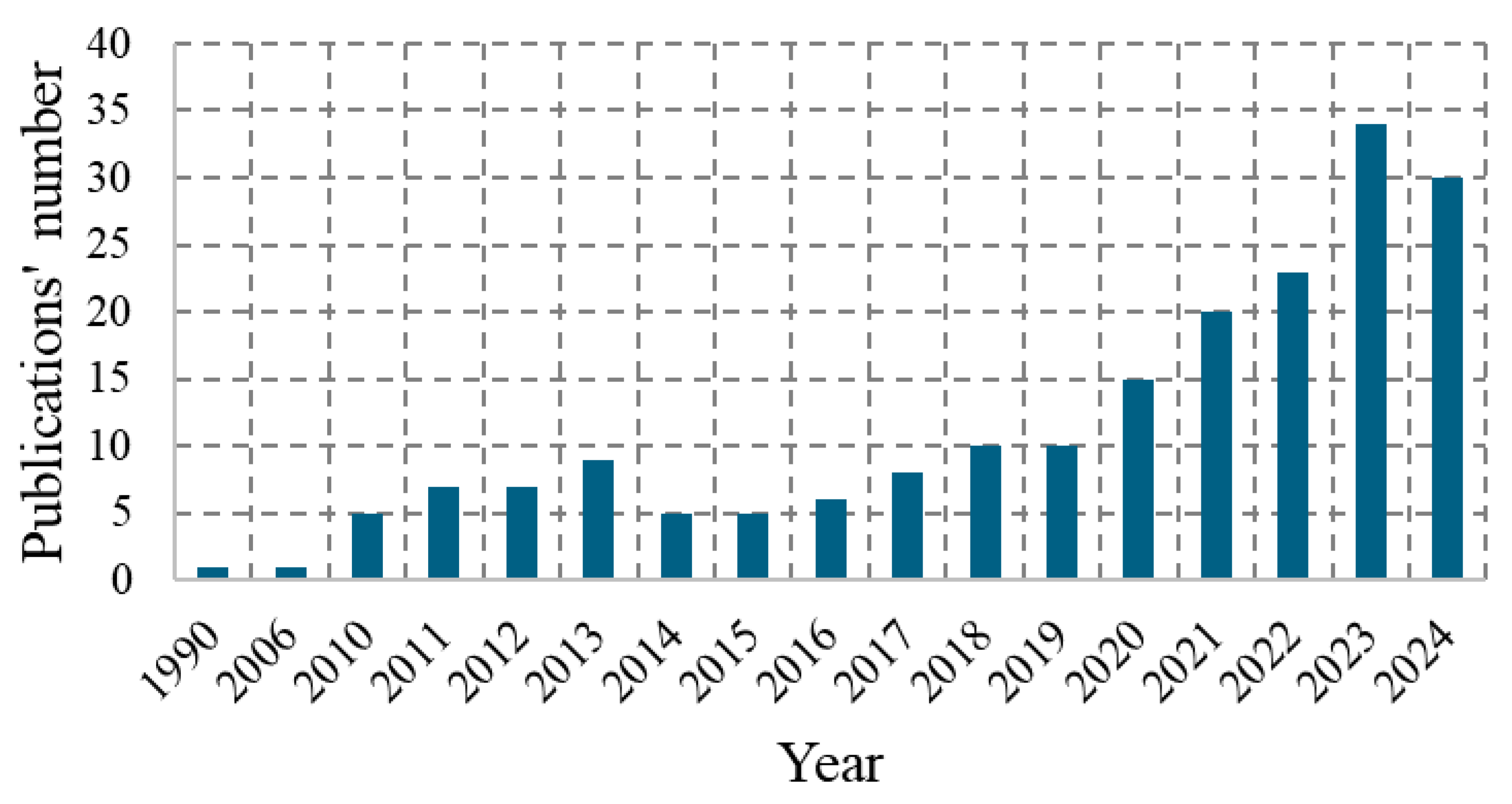

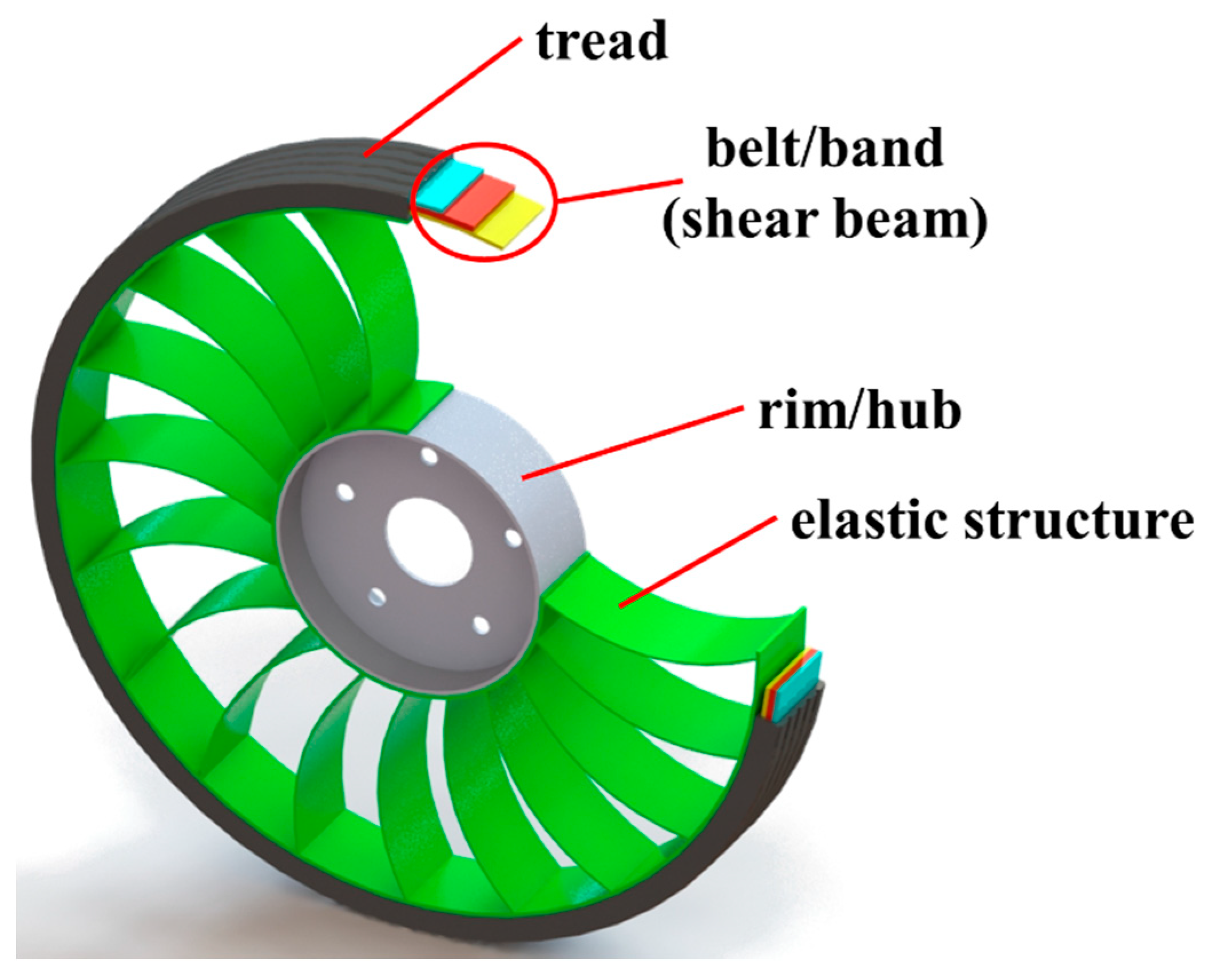
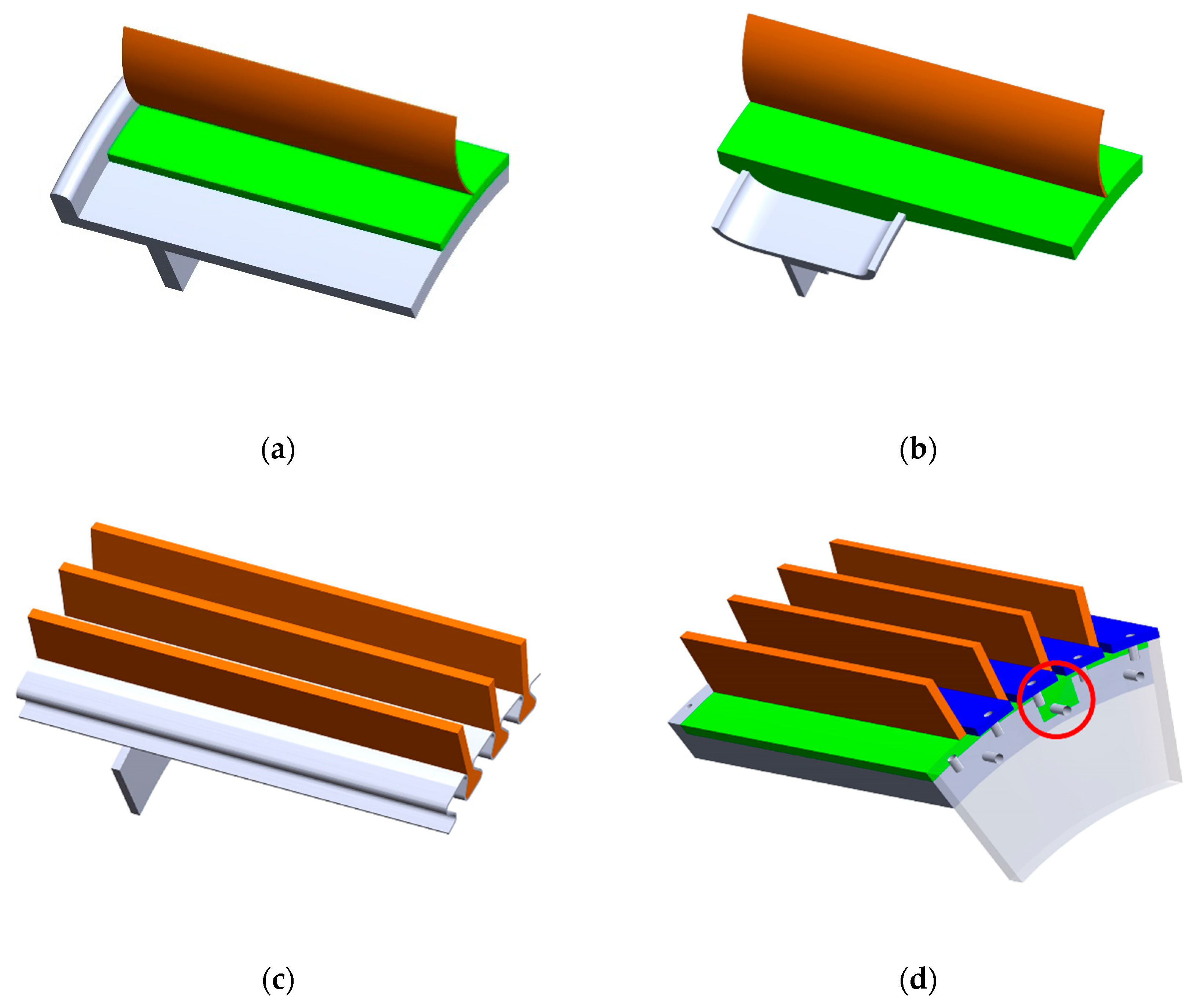
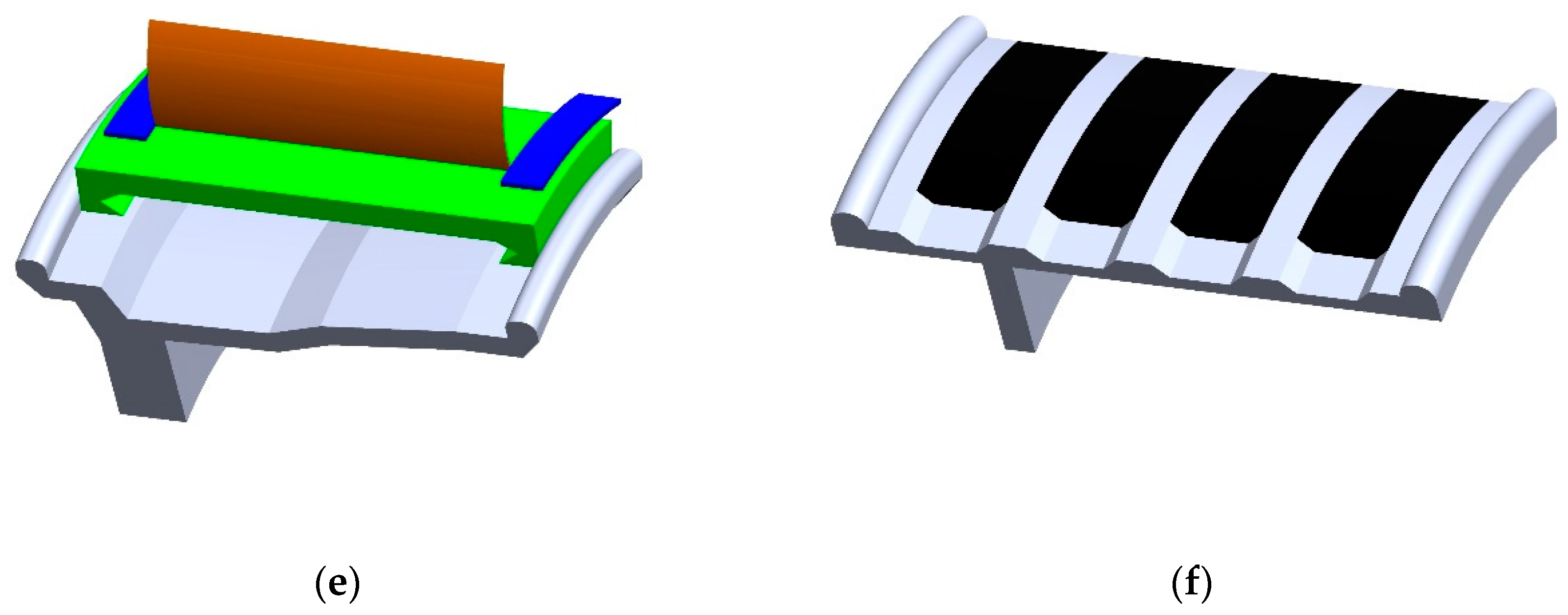
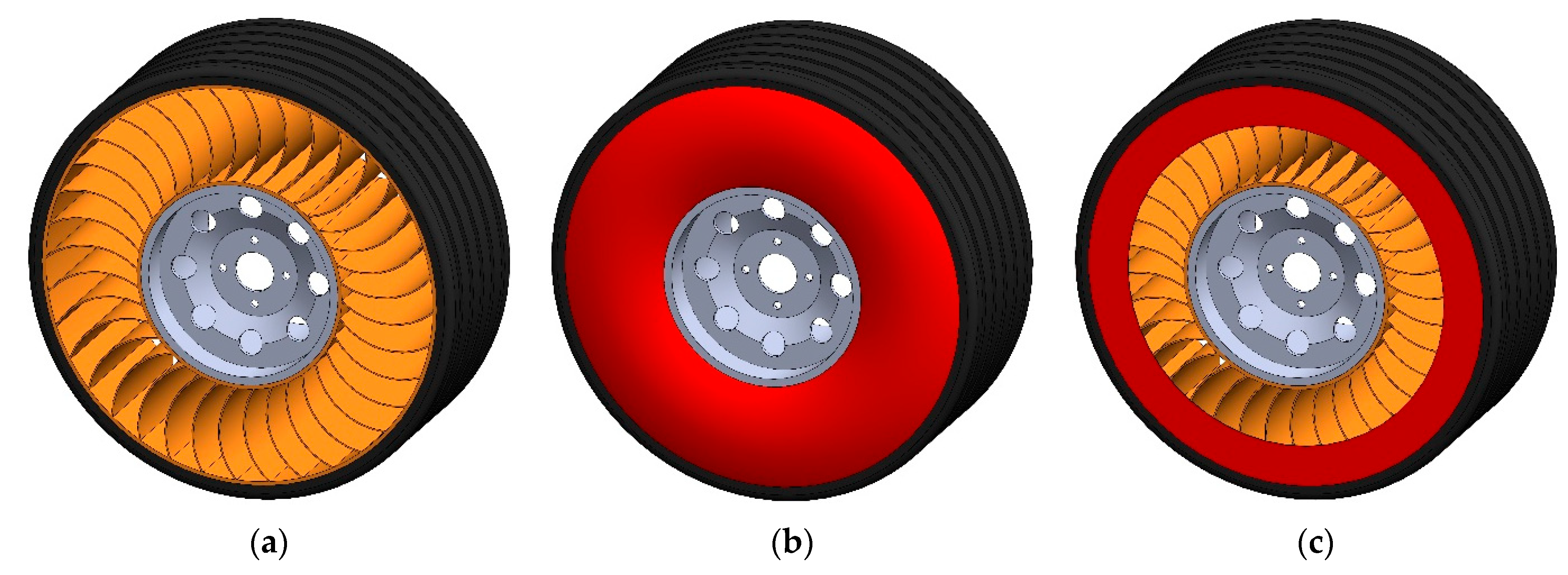
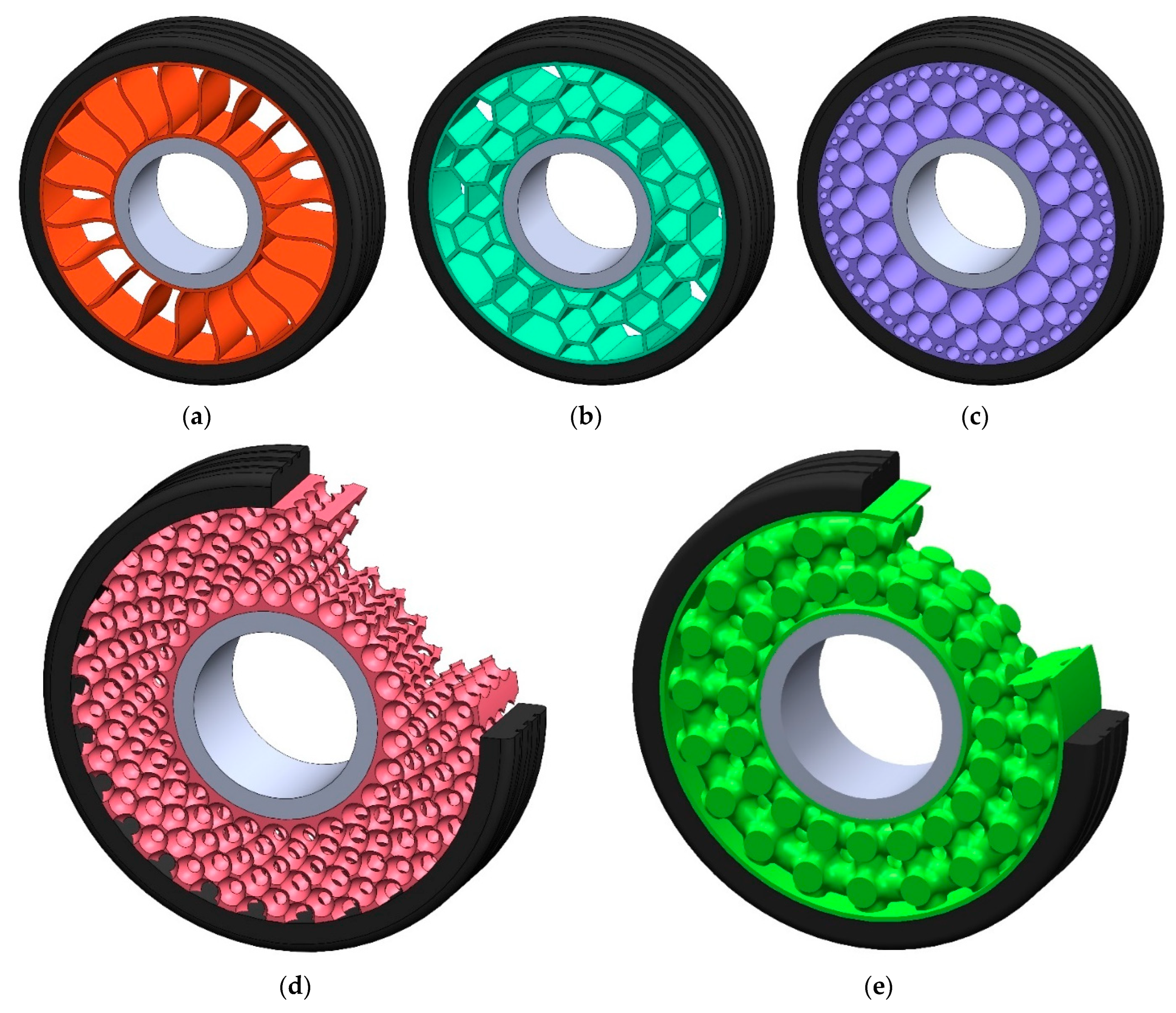
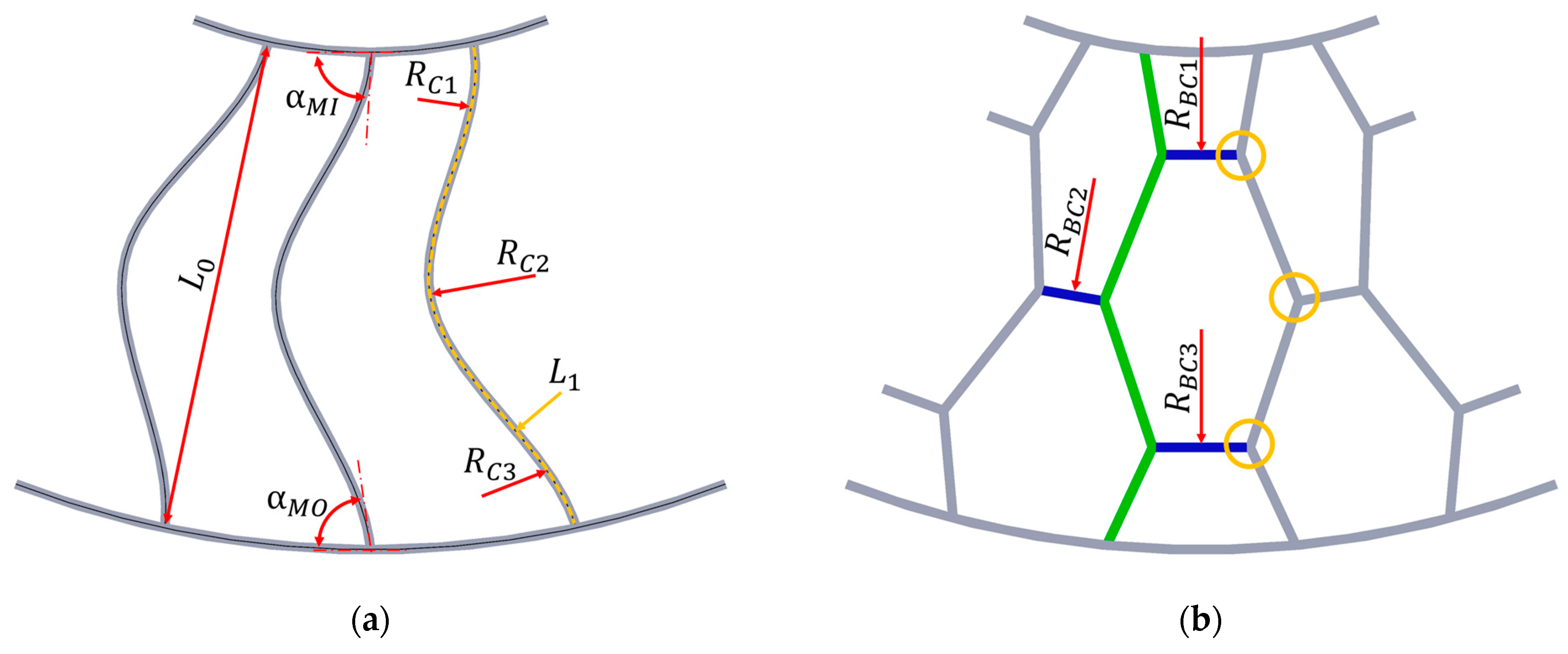
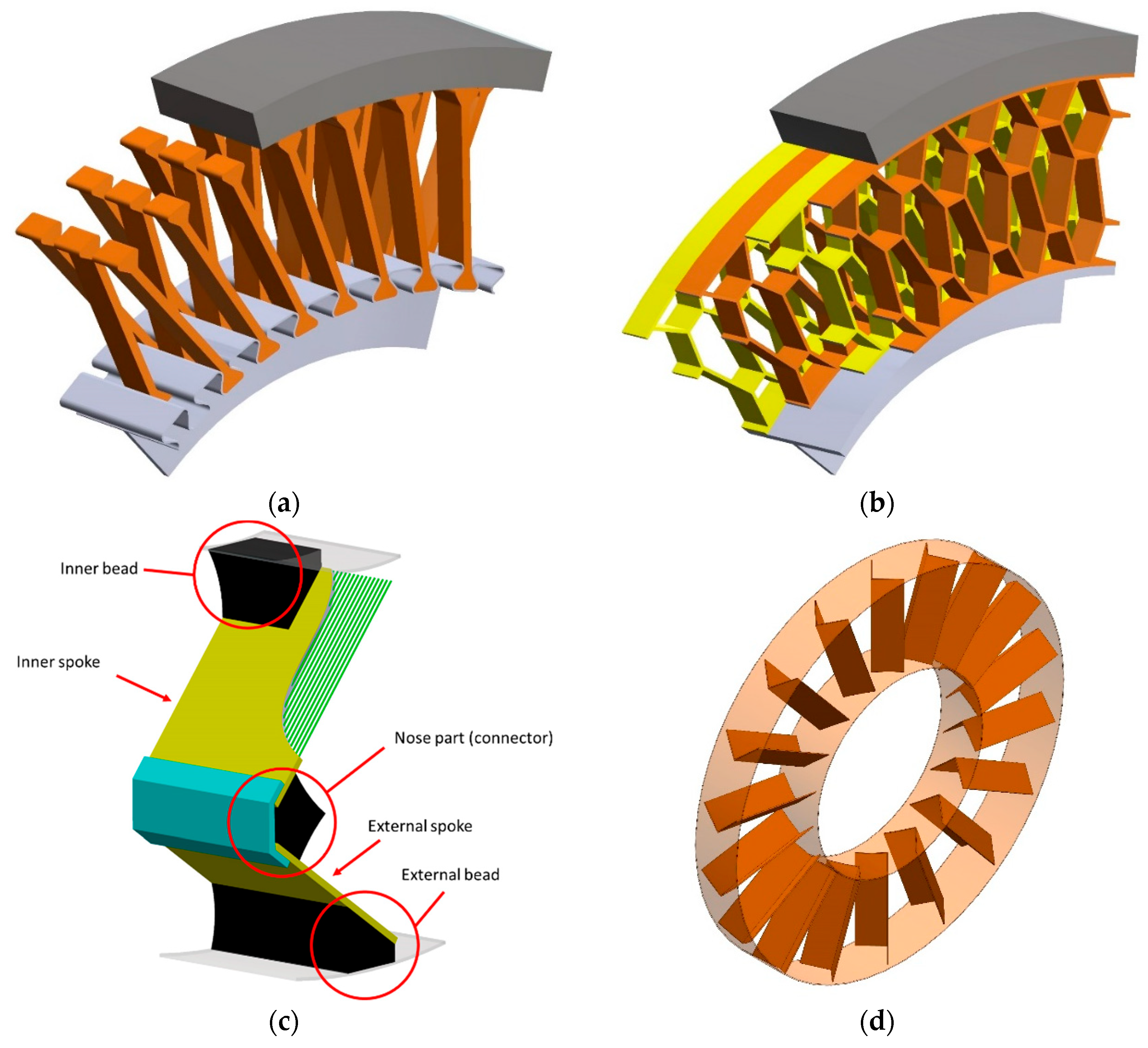
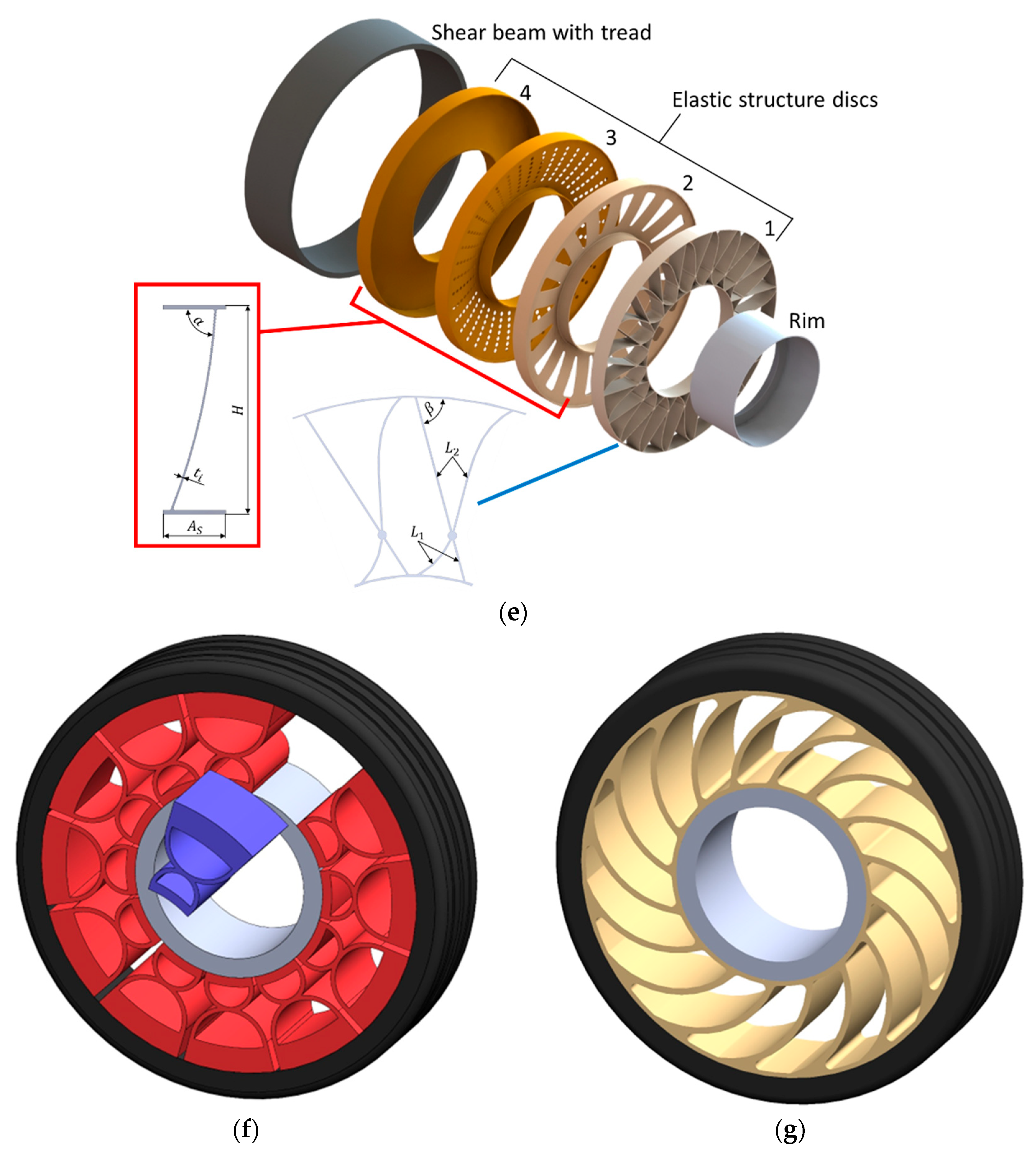
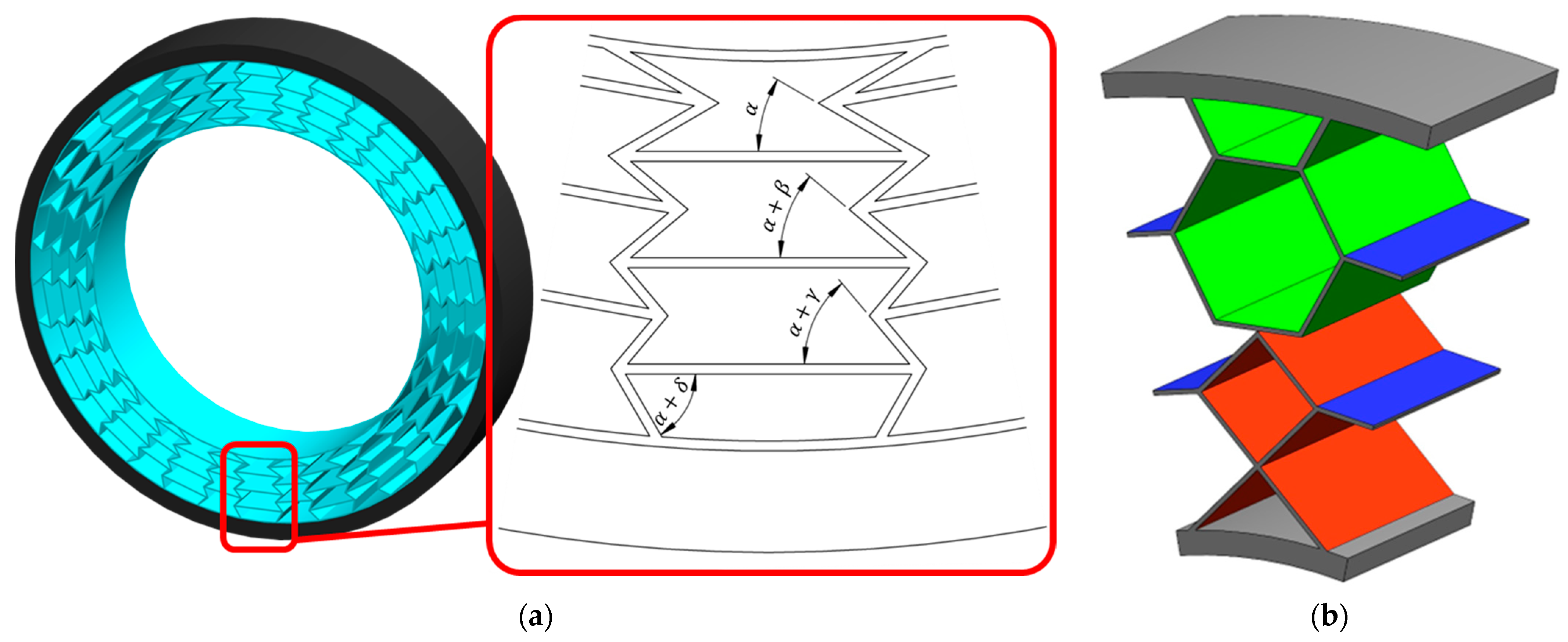
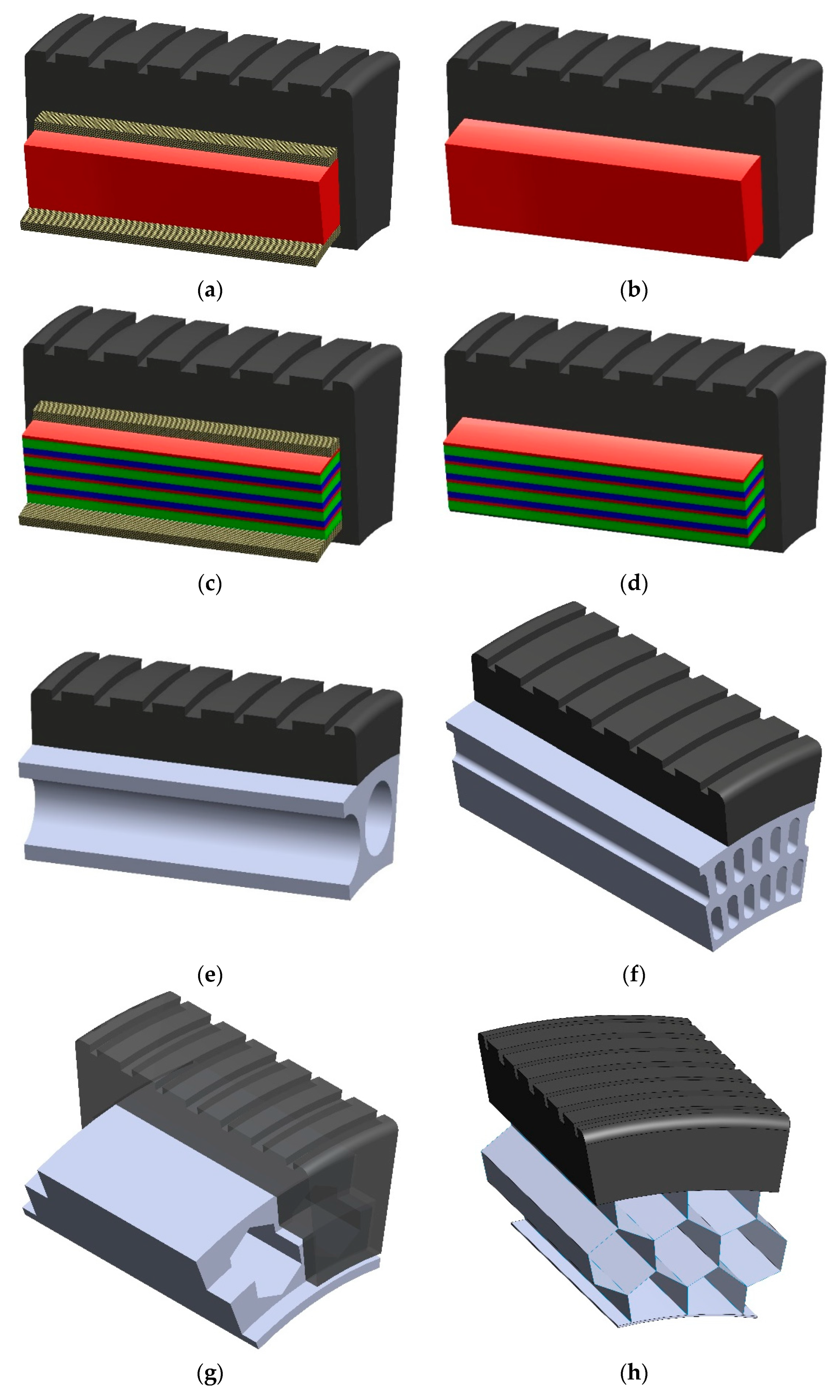

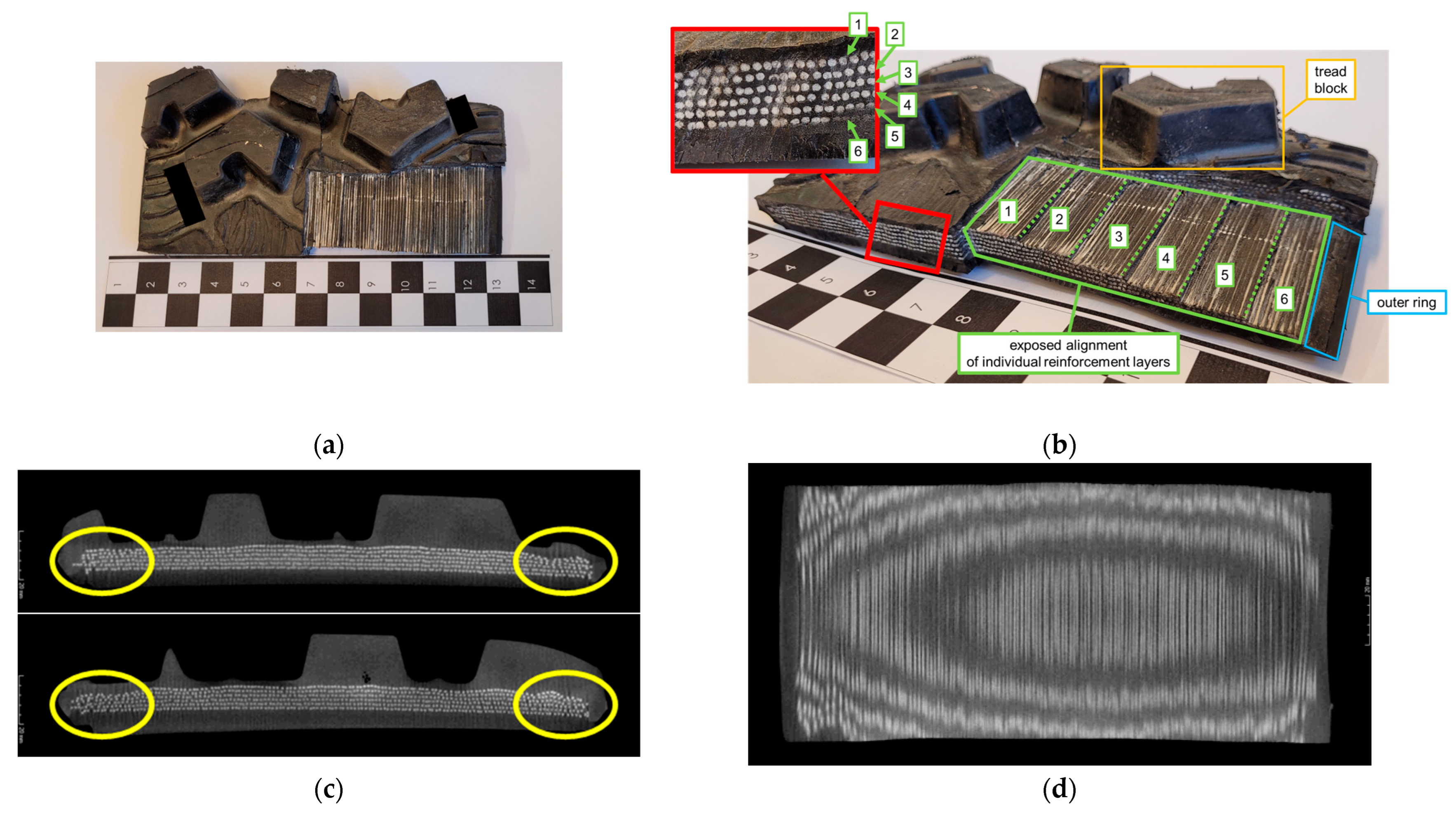
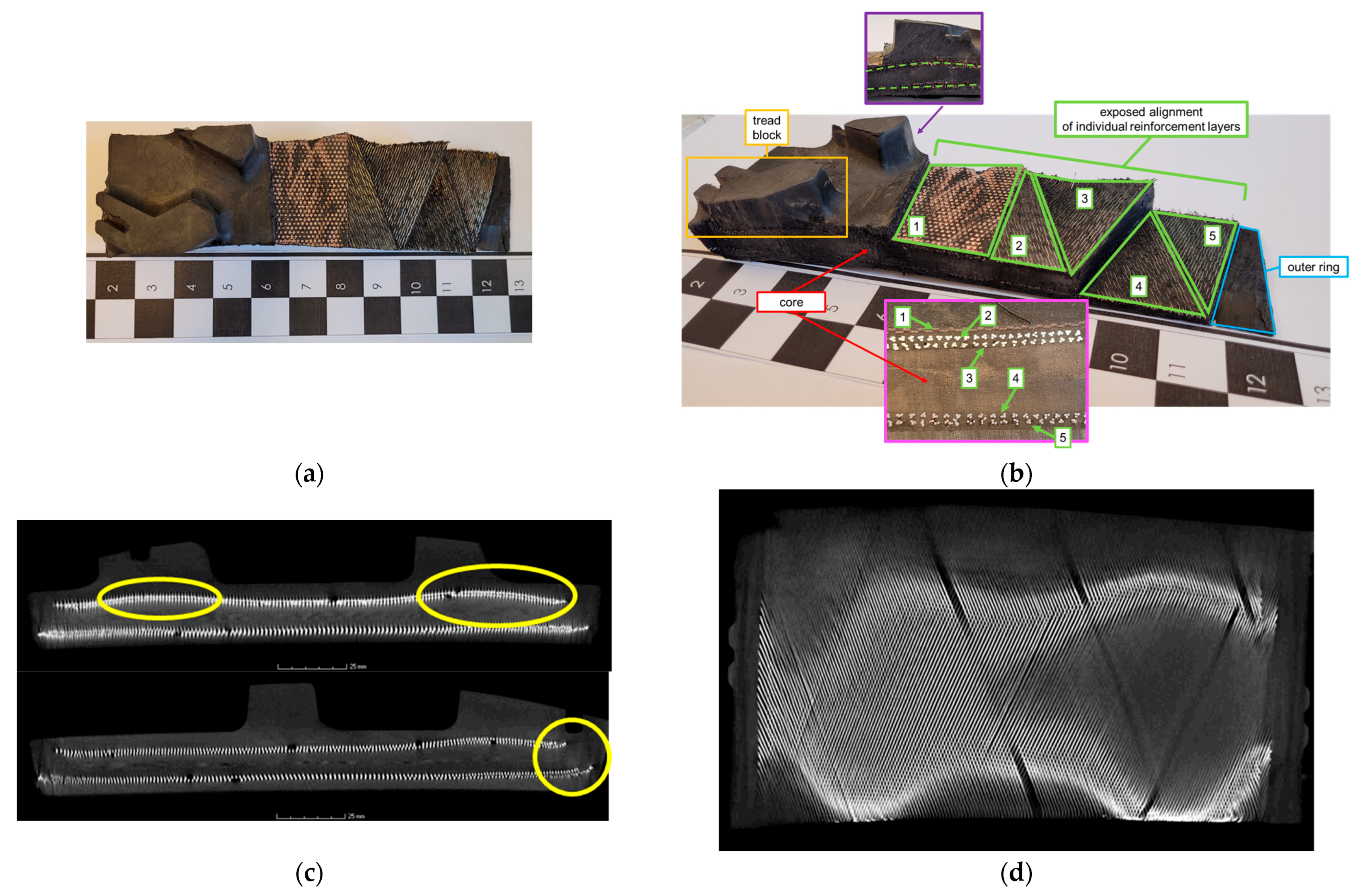
Disclaimer/Publisher’s Note: The statements, opinions and data contained in all publications are solely those of the individual author(s) and contributor(s) and not of MDPI and/or the editor(s). MDPI and/or the editor(s) disclaim responsibility for any injury to people or property resulting from any ideas, methods, instructions or products referred to in the content. |
© 2025 by the authors. Licensee MDPI, Basel, Switzerland. This article is an open access article distributed under the terms and conditions of the Creative Commons Attribution (CC BY) license (https://creativecommons.org/licenses/by/4.0/).
Share and Cite
Żmuda, M.; Jackowski, J. The Review of Selected Non-Pneumatic Tires Properties—Load Carrying Mechanism, Structure of Non-Pneumatic Tires. Materials 2025, 18, 1566. https://doi.org/10.3390/ma18071566
Żmuda M, Jackowski J. The Review of Selected Non-Pneumatic Tires Properties—Load Carrying Mechanism, Structure of Non-Pneumatic Tires. Materials. 2025; 18(7):1566. https://doi.org/10.3390/ma18071566
Chicago/Turabian StyleŻmuda, Marcin, and Jerzy Jackowski. 2025. "The Review of Selected Non-Pneumatic Tires Properties—Load Carrying Mechanism, Structure of Non-Pneumatic Tires" Materials 18, no. 7: 1566. https://doi.org/10.3390/ma18071566
APA StyleŻmuda, M., & Jackowski, J. (2025). The Review of Selected Non-Pneumatic Tires Properties—Load Carrying Mechanism, Structure of Non-Pneumatic Tires. Materials, 18(7), 1566. https://doi.org/10.3390/ma18071566







